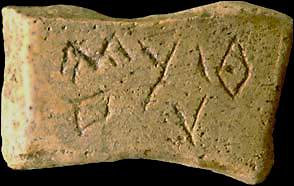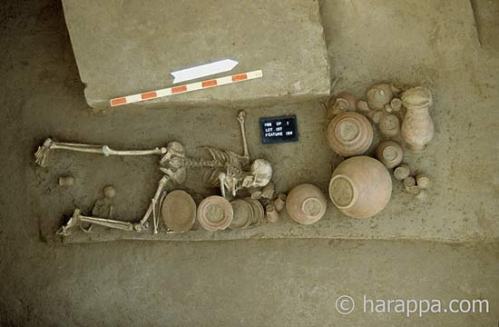The Indus Valley civilization(also known as Harappan culture) has its earliest roots in approximately 6000 BCE in Mehrgarh. The two greatest cities, Mohenjo-Daro and Harappa, emerged circa 2600 BCE along the Indus River valley in Punjab and Sindh. The civilization, with a writing system, urban centers, and diversified social and economic system, was rediscovered in the 1920s after excavations at Mohenjo-daro (which means “mound of the dead”) in Sindh near Sukkur, and Harappa, in west Punjab south of Lahore. A number of other sites stretching from the Himalayan foothills in east Punjab, India in the north, to Gujarat in the south and east, and to Balochistan in the west have also been discovered and studied. Although the archaeological site at Harrappa was partially damaged in 1857 when engineers constructing the Lahore-Multan railroad used brick from the Harappa ruins for track ballast, an abundance of artifacts have nevertheless been found.

One of the most fascinating yet mysterious cultures of the ancient world is the Harappan civilization. This culture existed along the Indus River in present day Pakistan. It was named after the city of Harappa which it was centered around. Harappa and the city of Mohenjo-Daro were the greatest achievements of the Indus valley civilization. These cities are well known for their impressive, organized and regular layout. They have well laid our plumbing and drainage system, including indoor toilets. Over one hundred other towns and villages also existed in this region. The Harappan people were literate and used the Dravidian language. Only part of this language has been deciphered today, leaving numerous questions about this civilization unanswered. Artifacts and clues discovered at Mohenjo-Daro have allowed archaeologists to reconstruct this civilization. The similarities in plan and construction between Mohenjo-Daro and Harappa indicate that they were part of a unified government with extreme organization. Both cities were constructed of the same type and shape of bricks. The two cities may have existed simultaneously and their sizes suggest that they served as capitals of their provinces. In contrast to other civilizations, burials found from these cities are not magnificent; they are more simplistic and contain few material goods. This evidence suggests that this civilization did not have social classes. Remains of palaces or temples in the cities have not been found. No hard evidence exists indicating military activity; it is likely that the Harappans were a peaceful civilization. The cities did contain fortifications and the people used copper and bronze knives, spears, and arrowheads. The Harappan civilization was mainly urban and mercantile. Inhabitants of the Indus valley traded with Mesopotamia, southern India, Afghanistan, and Persia for gold, silver, copper, and turquoise. The Mesopotamian model of irrigated agriculture was used to take advantage of the fertile grounds along the Indus River. Earthlinks were built to control the river’s annual flooding. Crops grown included wheat, barley, peas, melons, and sesame. This civilization was the first to cultivate cotton for the production of cloth. Several animals were domesticated including the elephant which was used for its ivory.
There’s some evidence that a IVC city is deep underwater in the bay of Cambay, but that’s pending further investigation. If it’s true, the pottery from it dates back over 30, 000 years. This is the earliest known example of Harappan writing, it may be the oldest in the world.

Harappan Astronomy
Although the translation of the Harappan script is still very much a work in progress, there are numerous indications that Harappans were well versed in astronomy.
- The straight streets of the Indus cities are oriented towards the cardinal directions, which presupposes astronomical observations and the use of the sun-stick, the gnomon.
- The star-calendar used by the Vedic ritualists was adopted by the Aryans in India, for there are no references to it in the Avesta or in the oldest books of the Rgveda. On the other hand, astronomical evidence dates the compilation of this calendar at around the 23rd century B.C., when the Indus civilisation flourished at its peak. Like other urban civilisations, it undoubtedly needed a calendar that adjusted the lunar and the solar time-reckoning.
- Linkages between ancient Harappan scripts and latter Vedic texts suggest that Harappan priest-astronomers tracked progress of Mercury, Venus and Saturn, and most likely all of the planets. They also appeared to have mapped the sky. Some of the pieces of recovered tablets show what appears to be a discussion of the North Star in one case and the star cluster, Pleides, in another.
The Pleiades hold a prominent place as the mothers or wet nurses of the newborn infant in one of the most ancient and central Hindu myths, that of the birth of the war-god Rudra/Skanda, who evidently represents, among other things, the victorious rising sun (and as vernal sun the new year). The Pleiades are said to have been the wives of the seven sages, who are identified with the seven stars of the Great Bear.
The Great Bear’s Old Tamil name elu-meen ‘seven-star’ corresponds to the combination of the pictograms ‘7’ + ‘fish’, which alone constitutes the entire text of one finely carved Indus seal. The Satapatha-Brahmana states that the six Pleiades were separated from their husbands on account of their infidelity; other texts specify that only one of the seven wives, Arundhati, remained faithful and was allowed to stay with her husband: she is the small star Alcor in the Great Bear, pointed out as a paradigm of marital virtue to the bride in the Vedic marriage ceremonies.
Evidence for the Harappan origin of this myth is provided, among other things, by Indus seals which show a row of six or seven human figures; their female character is suggested by the one long plait of hair, which to the present day has remained characteristic of the Indian ladies.
Culture and economy
Indus Valley civilization was mainly an urban culture sustained by surplus agricultural production and commerce, the latter including trade with Sumer in southern Mesopotamia. Both Mohenjo-daro and Harappa were built according to similar plans of well-laid-out streets, “differentiated living quarters, flat-roofed brick houses, and fortified administrative or religious centers”[4] Weights and measures were standardized throughout the area and distinctive seals were used for identification of property and shipment of goods. Although copper and bronze were in use, iron was unknown. “Cotton was woven and dyed for clothing; wheat, rice, and a variety of vegetables and fruits were cultivated; and a number of animals, including the humped bull, were domesticated.” [4] Wheel-made pottery—some of it adorned with animal and geometric motifs—has been found in profusion at all the major Indus sites. A centralized administration has been inferred from the revealed cultural uniformity; however, it remains uncertain whether authority lay with a priestly or a commercial oligarchy.
Archaeology
By far the most exquisite but most obscure artifacts unearthed to date are the small, square steatite seals engraved with human or animal motifs . Large numbers of the seals have been found at Mohenjo-daro, many bearing pictographic inscriptions generally thought to be a kind of script. Despite the efforts of philologists from all parts of the world, however, and despite the use of computers, the script remains undeciphered, and it is unknown if it is proto-Dravidian or proto-Sanskrit.



Harappan priest king 2,000 BC, and a terracotta figurine of lady.




Harappan seals, one showing a man in a seated yogic position.


Harappan jewellery.

Harappan cooking pots. Period III, Harappan, 2300-2200 B. C. Links to Harappan sites.http://www.mohenjodaro.net/http://www.harappa.com/har/moen0.html

Aerial view of the great bath at Mohenjo-Daro.

Ground view of the well.

A childs toy cart, showing they used the wheel.
Intact Buffware Vessel, Mehrgarh Style, 3500-2000 BC.
The human remains from the sites are the same physical type as the current residents of the areas they are found in, making Harappans Indo Europeans.
A burial at Harappa.

Burial of a woman and infant with offering pots.
Painted burial pottery.
Edit to original.
After a few months of reading into the history of agriculture, I’m pretty sure in saying the Harappans and their ancestors the people of Mehrgarh, were Indo Europeans. This is from a new dating of the spread of Indo European languages that matches the spread of the domesticated crops that you find in The Indus Valley civillisation. The wheat, sheep, goats and cattle all have the same place of origin in southern Turkey about 10,000 or so years ago. These are the agricultural markers for the spread of that culture, so where you get Indo-European crops, you’ll get Indo-European people (that far back in time, at least). the barley seems to have been domesticated in Asia, not the Israel?Jordan type



